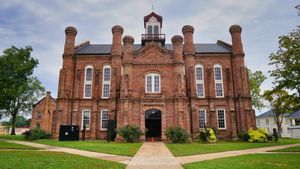A-level results day has arrived, bringing both excitement and anxiety for students across the UK. This year's results reflect not only the hard work of students but also some concerning trends about inequality and opportunity.
Hundreds of thousands of students nervously opened their A-level results, each grade holding significant weight for their future. These results serve as key indicators for university admissions and potential career paths, influencing public opinion about education standards.
For many students, achieving top grades is more challenging than ever, particularly following the changes to assessments due to the pandemic. This year has seen England revert to pre-pandemic grade boundaries, leading to the highest proportions of top grades since 2010.
Conversely, Wales and Northern Ireland faced their first year back at pre-pandemic standards, resulting in fewer top grades awarded. The mixed results highlight discrepancies within the UK education system.
Despite the optimism surrounding some individual success stories, widespread inequalities persist. Recent data indicates significant regional disparities, with students from the south-east achieving higher grades compared to those from the north-east.
For example, only 21.5% of the grades awarded to students from Lincolnshire were A or above, compared to 35.6% from Surrey. Such statistics stress the urgent need for governmental action to address educational inequities.
This year, 27,600 students from disadvantaged backgrounds secured university placements, marking encouraging progress. Yet, the overarching narrative is one of persistent disadvantage with geographical disparities evident across the country.
The secretary of state for education, Bridget Phillipson, has voiced concerns over the “baked-in” inequality entrenched within the education system. A recent survey reveals over 80% of respondents believe there is still a significant class gap affecting young people's educational opportunities.
While private school students enjoyed better success rates, being over twice as likely to secure top grades, their state-educated peers continue to struggle. This stark divide calls for immediate and effective policy interventions to level the playing field.
The roots of these inequalities dig deep, beginning well before secondary education. Experts argue early-years education is foundational and can significantly influence children’s development and future academic achievements.
The government’s commitment to reform should prioritize creating equitable opportunities throughout early childhood education. Developing systems to support children from disadvantaged backgrounds will pave the way for better exam outcomes down the line.
For students receiving A-level results, there's also the need to recognize these figures do not define their entire educational identity. Instead, these grades should be seen as stepping stones guiding them toward broader pathways.
Brighton and Hove continues to celebrate consistent success, boasting high attainment rates for the 11th consecutive year. This success translates to 98.3% achieving A-E grades, with 63.5% securing A-B grades.
Councillor Bella Sankey expressed pride over these impressive outcomes, highlighting the city as a nurturing environment for students. The results place Brighton above the national average and reinforce its reputation for academic excellence.
On the national spectrum, this year's A grades increased to 9.3%, climbing from last year’s 8.9%. Although the overall pass rate decreased slightly to 97.2%, the persistence of top performances marks significant achievements since the pandemic.
Interestingly, certain regions, such as East Sussex, particularly excelled, ranking third for A-A grades, with 34.4% of entries falling within this category. Meanwhile, West Sussex experienced minor drops compared to previous years, emphasizing inconsistent progress across the counties.
At Varndean College, students exhibited remarkable results, with nearly 98% passing their A-levels. Notable individual stories include Josh Buckland, who earned his chance to study abroad on a full academic scholarship after excelling with grades sufficient to secure his place at Virginia Wesleyan University.
Arwen Weston, another Varndean student, expressed her delight over achieving top grades, leading her to study Product Design at her chosen university. Students like Issac Wood and Sorin Hickinbottom also reflected on their journeys, showcasing resilience and commitment to their studies.
Principal Donna-Marie Janson expressed immense pride in her students, praising their hard work and determination throughout challenging circumstances. She believes their accomplishments today can inspire future generations.
At BHASVIC, numerous students are heading to prestigious universities, including Laurence Wakeford, who managed top marks across the board. His achievements reflect the exceptional standards and dedication prevalent within the college community.
Students at Newman College also exhibited promising results, with Niamh Marquess-Bowler and Rocco Di Riemzo both securing places at the University of Bristol. Their aspirations underline the intense competition and rigor faced during the A-level process.
Iona Fuhrmann is off to Oxford after achieving three A*s, embodying the high stakes involved for students aspiring to enter competitive fields like medicine. Her excitement stands as evidence of the dedicated paths many students are paving toward their futures.
Overall, this year's A-level results reveal not just academic milestones, but broader inequalities existing within the UK educational system. Answers and strategies must emerge swiftly to tackle the issues faced by many students, ensuring brighter futures for all.
But for the students receiving results today, it’s the opportunity to celebrate their unique paths and achievements. Despite the pressures and challenges of A-levels, these young adults now stand on the verge of exciting new journeys.



